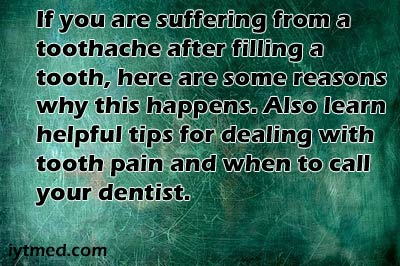Toothache after a filling is a surprisingly common experience for many people. While fillings are meant to alleviate pain caused by cavities, the discomfort that follows can leave patients puzzled and concerned. Understanding the reasons behind this post-treatment pain is essential to managing it effectively. In this article, we’ll explore why a tooth might hurt after a filling, what types of pain are normal, and when it may be time to revisit the dentist.
What Causes Toothache After a Filling?
Tooth pain after a filling can occur for several reasons, most of which are temporary and not a cause for alarm. Below are some of the most common causes:
| Cause | Description | Duration (Days) |
|---|---|---|
| Tooth Sensitivity | Sensitivity to hot, cold, or sweet foods; often due to nerve irritation | 2 – 14 |
| High Bite | Filling that is too high, causing pressure or misalignment | Persistent until fixed |
| Pulpitis | Inflammation of the pulp, which may occur after the drilling process | 1 – 7 |
| Allergic Reaction | Sensitivity to the filling material, such as metals in amalgams | Persistent until replaced |
Tooth Sensitivity
The most common type of discomfort after a filling is tooth sensitivity. This can happen when the filling material affects the nerve endings in the tooth, leading to heightened sensitivity to hot, cold, or sweet substances. According to a study published in the Journal of Dentistry, around 60% of patients experience some level of sensitivity immediately following a filling, which generally resolves within two weeks.
- Treatment: Toothpaste designed for sensitivity can help alleviate these symptoms. Products like Sensodyne are often recommended, and they cost around $6 to $8 per tube.
High Bite
Another common reason for post-filling discomfort is an improperly shaped filling that is too high, leading to increased pressure when you bite down. Even a slight misalignment can cause significant discomfort. Your dentist can correct this by adjusting the height of the filling during a follow-up visit.
- Symptoms: Pain when biting down, feeling like one tooth is hitting first.
- Solution: A simple bite adjustment by your dentist, which typically requires a brief visit.
Pulpitis: When Inflammation Strikes
Pulpitis refers to inflammation of the pulp inside the tooth, and it can be classified as either reversible or irreversible. Mild pulpitis is a common outcome after fillings, particularly if a large amount of decay was removed or the filling was deep. Reversible pulpitis, which means the pulp is inflamed but can heal, generally subsides on its own within a week.
- Statistics: Reversible pulpitis is reported in about 20% of cases involving deep fillings.
- Treatment: Over-the-counter pain relievers, such as ibuprofen, are often sufficient for managing discomfort. A bottle of ibuprofen costs around $5 to $10.
Comparing Filling Materials and Post-Filling Pain
| Filling Material | Pain Frequency (%) | Typical Discomfort |
|---|---|---|
| Composite Resin | 30% | Sensitivity to temperature changes |
| Amalgam | 25% | Metallic taste, occasional bite discomfort |
| Glass Ionomer | 10% | Generally minimal sensitivity |
Composite resin fillings, which are popular for their natural look, are more likely to cause initial sensitivity compared to amalgam fillings. Glass ionomer fillings, typically used for smaller cavities or for patients with a high risk of decay, have the lowest reported discomfort.
Modern Trends: Choosing the Right Filling Material
One notable trend in dental care is the increasing preference for composite resin fillings. These tooth-colored materials offer a more aesthetically pleasing result than traditional amalgam fillings, which have a metallic appearance. In fact, a recent survey revealed that 70% of patients now choose composite fillings for visible teeth.
However, composite fillings may cause more initial sensitivity, especially if the filling is large or located in a high-stress area. This has led to an increase in the use of glass ionomer materials in non-load-bearing teeth, as they offer better compatibility with the tooth structure and less post-filling pain.
Statistics on Toothache After Filling
Practical Example: Managing Toothache After a Filling
Consider a scenario where a patient has received a deep composite filling. On the first day, they experience sharp pain when drinking cold water. This sensitivity persists for five days but gradually diminishes. The dentist recommended using a toothpaste for sensitivity and avoiding very cold or hot foods for the first week, which helped to alleviate symptoms.
On the other hand, another patient who had an amalgam filling reported a mild metallic taste but no significant pain, which is consistent with general trends in the pain frequency table presented earlier.
When to Contact Your Dentist
While mild discomfort or sensitivity after a filling is normal, there are situations where you should reach out to your dentist:
- Persistent Pain Beyond Two Weeks: If the sensitivity or pain lasts for more than two weeks, it could be a sign of a more significant issue, such as irreversible pulpitis.
- Severe Pain: Intense, throbbing pain may indicate that the pulp has become irreversibly inflamed or infected, potentially requiring a root canal treatment.
- Pain While Biting: If pain occurs only when biting down, this is likely due to a high bite and should be addressed promptly to prevent further complications.
Advice from Our Editorial Team
Toothache after a filling can be uncomfortable, but it is usually manageable with proper care and awareness. The key is understanding the type of pain you’re experiencing. Sensitivity is common, especially with composite fillings, and typically fades within a week or two. If you feel consistent discomfort when biting or if the pain worsens, make sure to consult your dentist. Preventive measures, such as using toothpaste for sensitivity and avoiding extreme temperatures in food and drink, can significantly improve your comfort after a filling.









